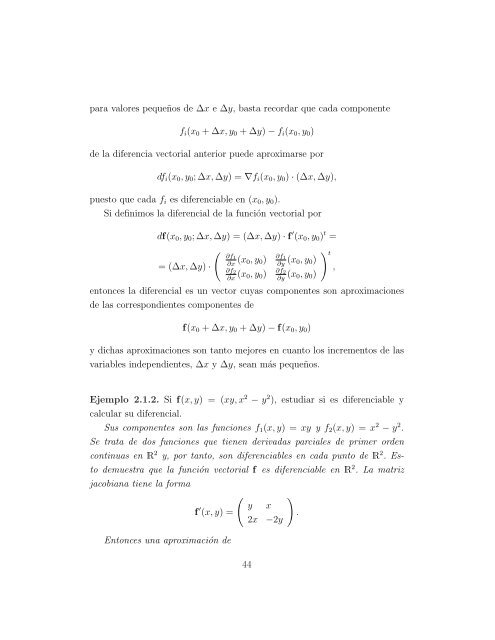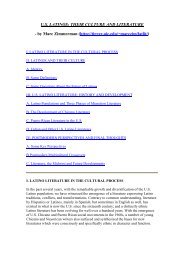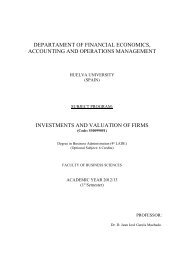2º Regla de la cadena y derivación implícita
2º Regla de la cadena y derivación implícita
2º Regla de la cadena y derivación implícita
You also want an ePaper? Increase the reach of your titles
YUMPU automatically turns print PDFs into web optimized ePapers that Google loves.
para valores pequeños <strong>de</strong> ∆x e ∆y, basta recordar que cada componente<br />
fi(x0 + ∆x, y0 + ∆y) − fi(x0, y0)<br />
<strong>de</strong> <strong>la</strong> diferencia vectorial anterior pue<strong>de</strong> aproximarse por<br />
dfi(x0, y0; ∆x, ∆y) = ∇fi(x0, y0) · (∆x, ∆y),<br />
puesto que cada fi es diferenciable en (x0, y0).<br />
Si <strong>de</strong>finimos <strong>la</strong> diferencial <strong>de</strong> <strong>la</strong> función vectorial por<br />
df(x0, y0; ∆x, ∆y) = (∆x, ∆y) · f ′ (x0, y0) t =<br />
<br />
∂f1<br />
∂f1<br />
t = (∆x, ∆y) ·<br />
∂x (x0, y0)<br />
∂f2<br />
∂x (x0, y0)<br />
∂y (x0, y0)<br />
∂f2<br />
∂y (x0, y0)<br />
entonces <strong>la</strong> diferencial es un vector cuyas componentes son aproximaciones<br />
<strong>de</strong> <strong>la</strong>s correspondientes componentes <strong>de</strong><br />
f(x0 + ∆x, y0 + ∆y) − f(x0, y0)<br />
y dichas aproximaciones son tanto mejores en cuanto los incrementos <strong>de</strong> <strong>la</strong>s<br />
variables in<strong>de</strong>pendientes, ∆x y ∆y, sean más pequeños.<br />
Ejemplo 2.1.2. Si f(x, y) = (xy, x 2 − y 2 ), estudiar si es diferenciable y<br />
calcu<strong>la</strong>r su diferencial.<br />
Sus componentes son <strong>la</strong>s funciones f1(x, y) = xy y f2(x, y) = x 2 − y 2 .<br />
Se trata <strong>de</strong> dos funciones que tienen <strong>de</strong>rivadas parciales <strong>de</strong> primer or<strong>de</strong>n<br />
continuas en R 2 y, por tanto, son diferenciables en cada punto <strong>de</strong> R 2 . Es-<br />
to <strong>de</strong>muestra que <strong>la</strong> función vectorial f es diferenciable en R 2 . La matriz<br />
jacobiana tiene <strong>la</strong> forma<br />
f ′ (x, y) =<br />
Entonces una aproximación <strong>de</strong><br />
<br />
44<br />
y x<br />
2x −2y<br />
<br />
.<br />
,

















